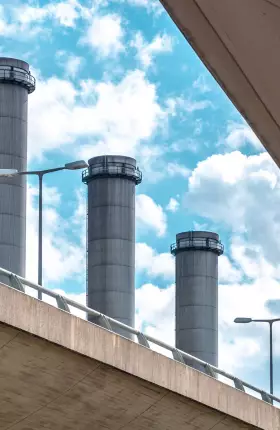When it comes to climate change, we’ve clearly entered a new era. Until now, many players in the mining industry had taken a wait-and-see approach. Today, the impacts of climate change, including skyrocketing costs from weather-related damage, are far more visible. Tomorrow, the effects of global warming could escalate further, leading to ever more drastic regulation, carbon taxation, changes in demand for mined commodities, and divestment pressures.
These threats call into question mining companies’ ability to continue operating successfully with their traditional business models and asset bases. Indeed, climate change—and especially the extreme weather events it brings—presents serious risks for mining sites that were constructed under outdated assumptions about how powerful a punch climate change can deliver. Given what we know now, it’s critical that mining companies move quickly with a holistic and systematic approach to managing climate risk.
The majority of mining companies are aware of the risks that climate change poses for their industry, and they’re taking action. But too many continue to underestimate the extent of the disruption that climate-related crises could deliver in the near future. Companies that still believe they can postpone taking action may end up paying a high price.
The Uncertainty Advantage
The typical response to climate change among mining companies has been to launch initiatives to enhance energy efficiency, secure water sources, and restructure portfolios to exit commodities (most notably, coal) that negatively impact the environment. But companies that go beyond this typical response can build an uncertainty advantage. Instead of merely reacting to uncertainty, companies can use uncertainty to their advantage by tracking the risks, crafting the right strategic responses, and strengthening their agility and resilience. (See “How South Africa’s Mining Industry Can Address Climate Change Challenges.”)
Companies can use uncertainty to their advantage by tracking the risks, crafting the right strategic responses, and strengthening their agility and resilience.
How South Africa’s Mining Industry Can Address Climate Change Challenges
How South Africa’s Mining Industry Can Address Climate Change Challenges
Because of South Africa’s particular mineral endowment, power and electricity grid constraints, and socioeconomic considerations, its mining industry faces significant climate change challenges. But by taking a few strategic pivots, companies (in fact, the industry as a whole) could gain a competitive advantage while combating global warming.
Today, about 80% of the country’s mining activity focuses on platinum group metals (PGMs), gold, and coal. While climate change’s impact on gold demand is expected to be roughly neutral, demand for PGMs could decline significantly because these metals are used in the catalyst systems of gasoline and diesel cars, and demand for coal is also likely to fall precipitously as countries move away from coal-powered electricity generation to limit emissions. South Africa currently has little or no access to deposits that contain the materials expected to benefit from climate change—particularly copper and battery metals (lithium, cobalt, and nickel).
To better position themselves, mining companies in South Africa should begin to ramp up exploration for commodities that are expected to be in higher demand because of climate change. Although deposits might exist, significant investment will be necessary to discover them. This would be a longer-term effort, requiring the support of both regulators and investors. Companies could also intensify their market development efforts related to the use of PGMs in fuel cells (for vehicles and stationary applications, as well as energy storage), which would partially compensate for the catalyst system demand losses.
Mining companies can also improve their operations in ways that will combat climate change and be economically advantageous, ultimately helping to maintain companies’ license to operate. For example, independent electricity generation from renewables such as solar and wind power is—subject to certain assumptions—already net positive for several operations, in some cases even allowing the operations to provide excess electricity to neighboring communities. Storing renewable energy for use when needed is still a challenge, but fuel cell development and deployment could help address the issue and boost demand for the platinum used to manufacture fuel cells, thus benefiting the mining industry in another way.
Implementing measures to address climate challenges will require all stakeholders, including mining companies, regulators, and investors, to collaborate diligently. Many mining companies hope that regulators will intensify their efforts to ease rules that currently make it difficult to invest in renewables. Regulators have recently taken steps in this direction, but more needs to be done.
By working together, the various stakeholders can shape a greener mining industry in South Africa—and one that is more competitive on the global stage.
To build an uncertainty advantage around climate change risk, mining executives should focus on three key priorities: developing a climate-conscious, scenario-based business strategy; climate-proofing their operations; and engaging stakeholders with an inspiring mission. Evidence suggests that the marketplace will reward those that do. According to BCG’s Smart Multiple analysis, mining companies that have been early movers in addressing climate change—that is, those in the top quintile of emissions reduction performance—have valuations that are, on average, 20% greater than those of their peers in the bottom quintile.
A Climate-Conscious Business Strategy
On the face of it, taking steps such as reducing exposure to coal and increasing exposure to battery metals such as lithium seems like an obvious way to pursue a more climate-conscious business strategy. But the best course of action is often not so obvious. After all, divesting coal assets only shifts the problem to another owner, and several mining companies have actually destroyed value by overcommitting to metals like lithium. Also, the true impact of climate change is far from certain, so companies need a strategy that is adaptable to a range of possible scenarios. In structuring their approach, mining company executives should consider the following questions:
- How will climate change affect demand, supply, and implied pricing for various commodities?
- What specific impact will those changes have on my company’s business?
- Which innovations or new material offerings might benefit our customers, and how can we turn those into new business opportunities?
By running scenarios and simulations, mining companies can start to gauge the various implications for the company’s portfolio and build effective response strategies. The more diverse their options for rebalancing their portfolio and minimizing negative exposure the better.
For example, to manage their portfolios, mining companies need to understand how profit pools will shift in the future as emissions are curbed. Demand for nickel and copper, for example, could benefit from the various abatement scenarios that are possible, while the story is much more mixed for other commodities. (See Exhibit 1.)
Some industry leaders have been very adept at scanning the market, tracking leading indicators, and listening to weak signals for clues about how to restructure their portfolios. For example, early movers picked up on weak signals about the thermal coal business—such as hedge funds reducing their exposure to coal—and decided to exit early. That will probably give them an advantage over companies that exit later, especially if the pool of eligible buyers shrinks or if tougher global carbon regulations crush coal’s profitability.
On the other hand, demand for coal will likely remain significant in the foreseeable future. And given that coal capacity expansions are limited, operators that remain in the coal business may cash in. The upshot? In grappling with portfolio decisions, miners must fully understand the specific context they’re operating in. Exiting coal might be the right choice for some companies (for example, those that face pressure from public investors), while entering or enhancing exposure to coal could benefit companies owned by specialized PE investors.
Shifting toward new green-energy metals is another example of portfolio innovation—and a very effective way to build resilience and optionality into the portfolio. Rio Tinto and Alcoa, for instance, have developed a new method to produce carbon-free aluminum (expected to reach the market by 2024), with support from the Canadian government, the province of Quebec, and technology giant Apple.
To manage their portfolios, companies must understand how profit pools will shift in the future as emissions are curbed.
Climate-Proofing Operations
By their nature, mining activities are resource intensive, and they are often located in regions that are particularly vulnerable to climate change. Mining company executives must therefore ask themselves three key questions:
- How can we reduce our direct and indirect carbon emissions footprint?
- How can we ensure operational resilience to the effects of climate change (for example, water scarcity)?
- How can we make climate issues integral to our business decisions, and how can we structure incentives and rewards to drive those decisions?
To climate-proof their operations, mining companies again need to run future scenarios to gauge the possible implications. The more diverse their response options, the better they can craft strategies for managing the impact of climate change on their operations, which vary considerably across commodities, geographical locations, and mining techniques, among other factors.
To address their scope 1 emissions (those from managed operations, including mines, processing, and power) and their scope 2 emissions (those from third-party providers that supply, for example, electricity or steam), mining companies have six main levers at their disposal—energy efficiency, fuel switching, renewable power, green hydrogen, methane capture, and carbon capture—and should try to work several simultaneously. (See Exhibit 2.) Mining companies can also look to adjacent industries to inform their emission reduction efforts. European steel players, for example, are investigating processes to avoid, reduce, and reuse CO2 emissions. They “avoid” through innovative replacement of carbon with hydrogen from water electrolysis. They “reduce” by adopting technologies with greater CO2 efficiency. And they “reuse” by utilizing process gases in the production of chemical products, such as bioethanol, fertilizer, synthetic fuel, and polymers.
While most mining companies have programs aimed at reducing greenhouse gas emissions (for example, by switching to less contaminating fuel such as natural gas), several have taken additional steps that focus on process innovation. Lithium Australia, for instance, has developed a way to extract lithium using processes that are less energy-intensive and less contaminating. And Northam Platinum has implemented a closed water circuit to ensure that 90% of the water used in its operations is recycled.
Barrick Gold is taking advantage of naturally occurring geothermal conditions to improve underground ventilation, thereby reducing winter heating and summer cooling requirements. According to the company’s 2018 sustainability report, these efforts reduced greenhouse gas emissions by 24% and lowered energy consumption by 10%.
Of course, every company’s circumstances are unique. Understanding which of the six reduction levers to use, how to apply them, and in what sequence is no simple task. Setting up dedicated centers of expertise that collect and analyze data in a structured manner across all of the company’s assets can help assess abatement potential, constraints, and costs. (See Exhibit 3.) And mining companies should remember that they don’t need to go it alone. The right partners can bring valuable expertise and capital to develop new technologies, which, in turn, can help the company respond faster to market changes. Whatever emission reduction plan the company chooses, however, it must manage the plan with the same rigor it would apply to the typical cost reduction plan.
Climate-proofing also addresses the practical matter of building resilience into operations so the company can recover from sudden climate-related disasters. Ensham’s decision to build levee banks around its central Queensland (Australia) mine helped avoid flooding during the wet season of 2010−2011. Two years earlier, the mine had suffered $300 million in damages when several coal pits were badly flooded. And since 2017, Barrick Gold has integrated digital weather forecasts into water usage models at its South American sites to more accurately predict weather-related water risks (such as reservoir depletion or floods) in real time.
An Inspiring Mission
Mining companies too often center their climate narrative on compliance. Instead, they should aspire to be more inspiring, making their position on climate change part of the company’s mission. The mission’s foundation should be a shared sense of purpose and values among employees, a clearly articulated vision for how the company will tackle climate change, and a disclosure framework with clear, independently verifiable practices for setting objectives, assessing progress, and keeping the company accountable on its sustainability goals.
It’s critical that companies engage stakeholders by using language that clearly links the mission to societal benefits and to the company’s long-term strategy for success. Only then will climate-related efforts get the attention and appreciation they deserve. By answering three key questions, mining company executives can improve the quality of their engagement and the impact of their efforts:
- What are the expectations of our internal and external stakeholders?
- Which disclosure standards and initiatives do we want to adopt?
- How can we shape a narrative about our company that is authentic, engaging, and coherent—a narrative strong enough to drive buy-in and change throughout the organization?
Because mining companies operate in a complex ecosystem of employees, communities, partners, customers, industry associations, investors, and government regulators, they need to nurture a strong internal and external narrative that is credible and consistent in its articulation of the climate change aspect of the mission, its strategic intent, and its initiatives. And there is no question that stakeholders are paying attention. Consider the recent announcement by BlackRock, the world’s largest asset manager, that it will now be making investment decisions with environmental sustainability as a core goal. Moreover, it will take a tougher stance against corporations that do not fully account for environmental risks and will exit certain investments, such as those in thermal coal producers, that “present a high sustainability-related risk.”
The mining ecosystem includes groups (for example, the Task Force on Climate-Related Financial Disclosures and the Climate Disclosure Standards Board) that give recommendations on what and how to disclose, groups (such as the UK’s CDP and the global Transition Pathway Initiative) that evaluate and score how well companies address climate impacts and adhere to reporting initiatives, and investor initiatives (for example, the Global Investor Coalition on Climate Change and the Institutional Investors Group on Climate Change) that require companies to achieve certain scores or rankings.
The CDP, to take one of the examples above, keeps a strong focus on climate change. On the basis of questionnaires, it calculates scores and publishes an A-list of companies that are leading on environmental transparency and performance. More than 6,300 companies participated in 2017, and investors use CDP scores in their decision making. The impact of these scoring systems is enormous and growing. In 2017, the investors that utilized CDP scores had $87 trillion in assets under management.
But to truly engage and convey an inspiring narrative, mining companies need to do more than be transparent; they need to demonstrate their leadership on climate change issues whenever possible. BHP, for example, has committed to setting public goals in 2020 for reduced greenhouse gas emissions, and it plans to tie executive pay more closely to environmental responsibility targets.
Mining companies need to demonstrate their leadership on climate change issues whenever possible.
By engaging the ecosystem of partners, customers, industry associations, investors, and government regulators, mining companies put themselves in a position to react nimbly to new sustainability challenges and build an uncertainty advantage. For example, by participating in government and cross-industry collaborations, they can help shape the sustainability agenda instead of just reacting to it.
Managing Climate Risk Holistically
Umicore is a great example of a company that focused on all three key priorities—developing a climate-conscious business strategy, climate-proofing operations, and engaging stakeholders with an inspiring narrative—as it transformed itself from a mining player to a materials-tech leader. It sold off most of its copper and zinc smelters and acquired capabilities and technologies centered on primary-metals recycling. As early as 2013, it was operating at the frontier of the clean-tech economy, generating €2.4 billion in revenues and significantly reducing the impact of metal-related emissions on air and water. That year, it ranked first on the Global 100 Index of the world’s most sustainable companies—something that surely grabbed the attention of investors, employees, and customers. While Umicore is a good example of what a company can do, it obviously doesn’t make sense for all mining companies to exit mining. Each company must find its own way to address climate change.
In the 2020s, more companies will need to choose a bold path, as Umicore did. Indeed, given the reality of climate change and its escalating costs, we believe that any remaining climate change laggards in the mining industry face a very precarious future. Regulators and shareholders have a role to play in supporting companies in their efforts to tackle climate change issues. But make no mistake, the bulk of the responsibility lies with mining executives. There is no time to waste.
BCG’s Center for Climate & Sustainability
We partner with clients across the public, private, and social sectors to align their strategy, operations, and stakeholder engagement with a low-carbon world. Our work is supported by BCG’s range of consulting experience across all industries and capabilities, as well as by our expanding reach of brands.














